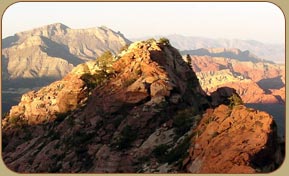Climbing at Red Rock Canyon
With more than 2,000 climbing routes, Red Rock Canyon National Conservation Area is one of the top five climbing destinations in the United States.
Routes range from short boulder problems to big wall climbs that take two or more days to complete. Multi-pitch routes may have a variety of climbs on each pitch fo the route, such as chimneys, friction, overhangs, cracks or face climbing.
If it rains...
The sandstone becomes very brittle when it rains (or is damp from snow) and should not be climbed for a least 24 hours. By allowing the sandstone to dry out, you will avoid breaking hand and foot holds and you will not have to worry about gear pulling out druing a fall. If you find yourself waiting for dry weather, you can climb limestone sport crags in Red Rock or in other areas around Las Vegas.
Climbing Permits
Late Exit Permits (LE) provide an additional three hours of climbing time after the normal closure of the 13-Mile Scenic Drive. These permits are available for the following areas: Angel Food Wall, Ice Box Canyon, Juniper Canyon, Pine Creek Canyon, and Oak Creek canyon. Late exit permits are not issued for sport climbing areas including Calico I, Calico II, Sandstone Quarry and Willow Springs. The fine for getting out late is $150.00!!
Overnight Permits (ON) are only available for routes on the following walls: Mt Wilson (1-2 nights), Levitation Wall (1 night), Rainbow Wall (1-2 nights), Buffalo Wall (1-3 nights), Hidden Wall (1-3 nights), and Bridge Mountain (1 night). Camping is not permitted at the base of any route.
Why are the rocks RED?
More than 600 million years ago, the land that would become Red Rock Canyon was the bottom of a deep ocean basin. Over time, changing land and sea levels resulted in the deposition of both ocean and continental sediments that became the gray limestone found at Red Rock Canyon today. About 180 million years ago, a giant sand dune field formed over what became the Western United States. Powerful winds shifted the sands back and forth, forming angled lines in the sand. Over time, the sheer weight of the layers of sand compressed into stone. This formation, locally known as Aztec Sandstone, is quite hard and forms the cliffs of Red Rock Canyon. Exposure to the elements caused some of the iron-bearing minerals to oxidize. This oidizing process can be more easily thought of as a "rusting of the sand," which resulted in red, orange and tan colored rocks. (From Keystone Visitor Guide)
Red Rock is Dog Friendly
You can bring your dogs along on your hike or climb, but the BLM asks that you clean up after your dog and dispose of the waste properly. That means, bring along some poop bags, as they are not provided by the park. They also say that "all dogs must be on a leash six feet long or less".
What if the Weather is Bad?
Las Vegas is centrally located to some of the best climbing and hiking areas in the southwest. And we have the cheapest flights and car rentals. If it's raining in Red Rock, check the weather links for Zion National Park, Joshua Tree National Park, the Eastern Sierras, areas in Utah and Arizona and the Grand Canyon.







